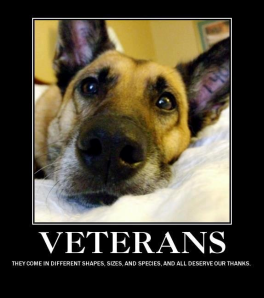With the celebration of Veteran’s Day on November 11th, I thought I would highlight the contributions of animals to the military across the world.
-
Horses have been used for over 5,000 years in warfare. The first training manual for chariot horses dates back to 1350 B.C. Historical horses include Alexander the Great’s Bucephalus; Comanche, who survived the Battle of the Little Big Horn; and General Lee’s Traveler. Donkeys and mules were also used in addition to oxen. In World War I, eight million horses died.
-
In the 1850’s there was a US Camel Corps. They were disbanded during the Civil War.
-
Hannibal may have used war elephants, but the enemies quickly learned that using squealing pigs caused the elephants to stampede.
-
In the trenches of World War I, soldiers used jars of European glowworms as lanterns.
-
Homing pigeons use in war date back to the ancient Greeks and Persians. In World War I, killing or hurting a homing pigeon in Britain carried a six month jail sentence. Sixteen thousand homing pigeons were parachuted into Europe during World War II. Gustav delivered the first news to England of the D-day landings in Normandy, after flying 150 miles.
-
The US Navy Marine Mammal Program trained killer whales, seals, bottle-nosed dolphins, and sea lions to mark sea mines, investigate suspicious objects, retrieve lost items, and guard harbors against enemy divers.
-
Dogs have multiple roles in the military throughout history. Four thousand dogs served in Vietnam (most of whom were euthanized rather than being returned home). They have served as mascots, guards, trackers, mustard gas alerts, messengers, and detectors of explosives. They also continue to serve our veterans after they return home as therapy and service dogs.


